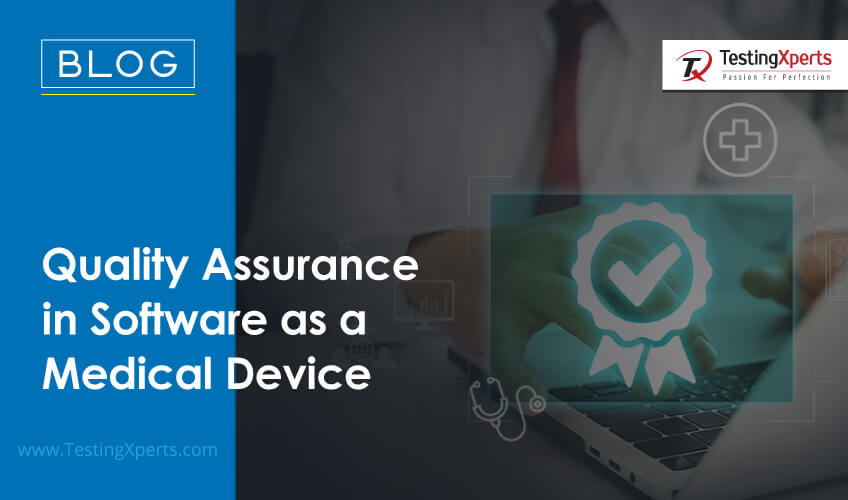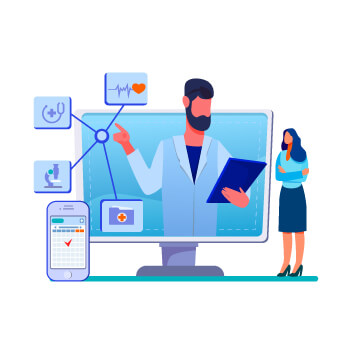
Table of Contents
- What is Software as a Medical Device?
- Regulatory Standards for SaMD Development
- Importance of Quality Assurance in SaMD
- Conclusion
- Why Choose TestingXperts for SaMD Testing?
What would happen if a medical device malfunctions during a diagnosis or during an operation? The reason could either be a faulty device or buggy software. If the reason is the latter, it would raise concerns over the quality and reliability of the software and the brand that manufactures it. This is why it is important to ensure that the medical device and its software meet the regulatory standards of the region or country before it debuts in the market. The ongoing digital transformation also affects the operational efficiency of medical devices and their software.
In recent years, the demand for developing Software as a Medical Device (SaMD) has been very high. According to the MDIC report, the global market for SaMD will reach 86.5 billion $ by 2027. This statistic reflects the growing dependency on technology in medical treatment and diagnostics. Now, the question is, how can businesses ensure that their SaMD products are reliable and of the highest quality? The answer to that question is the “Quality Assurance Process.” It plays a crucial role by ensuring these software solutions deliver optimal patient care of the highest quality and meet regulatory standards.
What is Software as a Medical Device?

SaMD is a class of medical software that carries out multiple medical functions without integrating with other medical devices. It was classified by the IMDRF (International Medical Device Regulators Forum), in which the European Union (EU) and Food and Drug Administration (FDA) are stakeholders, along with other countries. According to IMDRF, such software need not be a part of the medical device, as it can function independently.
It transforms digital health technology by simplifying complex medical tasks like diagnostics, treatment suggestions, and handling clinical management. Following are some of the examples of SaMD usage:
• Software using patient data to diagnose medical conditions, such as using images from MRI machines for diagnostic purposes.
• An application used to monitor patient conditions remotely, such as blood sugar levels, heart rate, and hemoglobin, for chronic disease management.
• A sleep-monitoring mobile app using a smartwatch/camera/microphone to access and transmit the data to the sleep lab.
• Software used to regulate medical devices in a patient, such as pacemakers.
• Software that collects huge amounts of data from various sources, like x-rays, CT scans, etc., to create 3D models for doctors to use in diagnostics or developing a treatment plan.
Regulatory Standards for SaMD Development
Regulatory standards are essential security measures to ensure medical software is reliable, effective, and safe. Given the importance of patient health and data, SaMD must fulfill the regulatory requirements, varying from country to country. The global regulatory framework for Software as a Medical Device is set by IMDRF, which categorizes it based on the data it allocates to healthcare decisions. IMDRF standards ensure that SaMDs are developed and maintained by prioritizing patient efficacy and safety.
In the USA, the FDA regulates SaMD under medical device provisions. It classifies Software as a Medical Device under multiple categories depending on the risk associated. Each category has its regulatory requirements; for example, software meant for diagnosis or treating life-threatening conditions should follow rigorous scrutiny as compared to wellness apps. In the UK, SaMD falls under the In Vitro Diagnostic Regulation (IVDR) and Medical Devices Regulation (MDR). Under these regulations, developers and manufacturers must justify their software to fulfill quality, safety, and performance benchmarks. SaMD manufacturers must fulfill these regulations to access the European Union Market.

Following are the top three regulations that businesses should follow when developing a SaMD:
ISO 14971:
It specifies the risk management processes of Software as a Medical Device, in vitro medical devices, and medical devices. This regulation outlines a roadmap for medical device development to identify their associated risks and implement proper control measures.
21 CFR Part 820:
It states that businesses should document and control SaMD design and development activities into release and post-release according to the 21 CFR Part 820 requirements checklist.
IEC 62304:
This regulation specifies the framework for the medical device software lifecycle’s activities, tasks, and processes. IEC 62304 defines the lifecycle for SaMD, its component, and software used to produce a medical device.
Importance of Quality Assurance in SaMD Development
Quality assurance is fundamental to SaMD development to ensure medical software applications’ safety, effectiveness, and integrity. The primary role of QA is to ensure patient safety. The process involves integrating testing into the development stage to identify and rectify bugs, errors, and malfunctions that could result in patient harm. QA is important to ensure the product complies with global and regional regulatory standards. It plays a significant role in building trust among healthcare providers and patients as they will adopt tested and proven reliable software. This is a critical aspect of SaMD development.

Following are some of the testing types that businesses need to integrate during SaMD development:
Performance Testing
Evaluate SaMD’s scalability and performance by measuring stability, response time, and resource utilization under various workload scenarios. By conducting thorough performance testing, developers can measure the endurance of the software without negatively affecting the user experience.
Functional Testing
Verify SaMD functionality by testing every component, feature, and module to ensure they perform as they are meant to. Functionality testing includes system testing, unit testing, and integration testing. Businesses should make sure to identify and rectify any functionality issues before releasing the product.
Compatibility Testing
SaMD should work seamlessly with different operating systems, configurations, platforms, and devices. Compatibility testing ensures the software runs accurately and delivers expected results across varying environments.
Usability Testing
Run usability tests to analyze how efficiently the users can use SaMD by gathering feedback, conducting surveys, and performing human observations. Usability testing can identify design flaws, navigation errors, UI issues, and improvement areas.
Security Testing
Identify the weaknesses and vulnerabilities in the security framework of SaMD by running repetitive security tests. Test for potential security breaches, unauthorized access, phishing attacks, data breaches, etc., to ensure that the finalized product protects patient health and personal records and complies with security standards.
Interoperability Testing
Before integrating SaMD with medical devices or EHR systems, businesses must conduct interoperability testing to ensure the software can seamlessly communicate and exchange data with external systems. It involves evaluating data exchange formats, compatibility with interoperability standards, and testing protocols.
Compliance Testing
Medical device software manufacturers must ensure that the SaMD complies with regulatory standards specific to the healthcare industry. Compliance testing validates whether the product meets the necessary guidelines set by various bodies such as the FDA, EU MDR, etc.
The testing requirements for SaMD development can vary according to risk classification, regulatory guidelines, intended use, etc. Businesses must ensure that the testing process aligns with the applicable industry best practices and standards.
Conclusion
The growing dependency on Software as a Medical Device in the healthcare sector highlights the critical role of integrating QA processes during development. If the device malfunctions due to software bugs, it will seriously affect the patient’s safety and trust. The SaMD must meet regulatory standards across different regions, such as the FDA in the USA and EU MDR in the UK. The quality assurance process consists of various testing types focusing on the product’s functionality, performance, security, compatibility, interoperability, usability, and compliance structure. Each testing type helps identify and resolve potential issues that could negatively affect data security.
Why Choose TestingXperts for SaMD Testing?
TestingXperts has extensive experience providing secure software testing services by considering regulatory reforms, affordability, structural changes, and accountability in the healthcare industry. Partnering with TestingXperts for Software as a Medical Testing Service will ensure you have higher performance and better security protocols. It will ensure that no harm (directly or indirectly) can be done to the patient. Our core services include:

• Test advisory and consulting
• Functional, performance, and usability testing
• Test automation in SaMD development
• SOA testing
• Compliance testing for FDA, ICD 10, HIPAA, EU MDR, etc.
• Mobile application testing
• Consult our medical software testing experts to learn more about the best practices and advisory for Software as a Medical Device.
Discover more
Get in Touch
Stay Updated
Subscribe for more info




